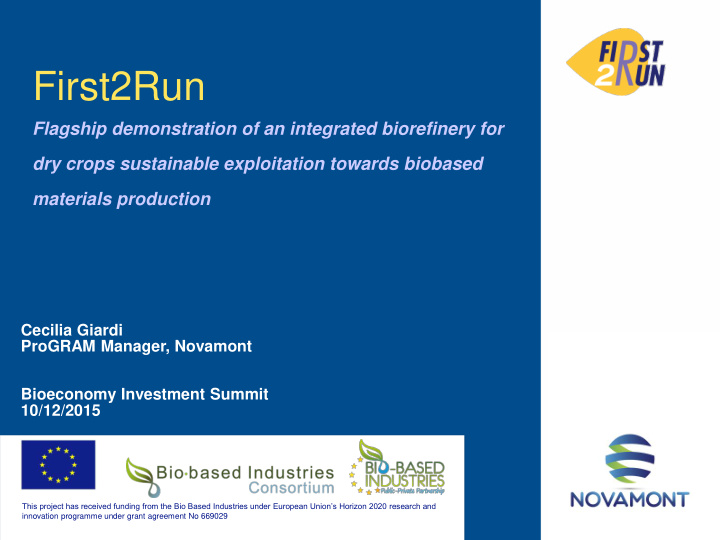



First2Run Flagship demonstration of an integrated biorefinery for dry crops sustainable exploitation towards biobased materials production Cecilia Giardi ProGRAM Manager, Novamont Bioeconomy Investment Summit 10/12/2015 This project has received funding from the Bio Based Industries under European Union’s Horizon 2020 research and innovation programme under grant agreement No 669029
AGENDA Facts & Numbers Scope & Objectives Consortium Macro objectives Impacts BBI_JU: opportunities and potentialities Website : www.first2run.eu
FACTS & NUMBERS Horizon 2020 / BBI-JU; Call: H2020-BBI- PPP-2014-1 Topic: BBI.VC3.F1/ Type of action: BBI- IA-FLAG Action type: innovation Action 6 partners from 4 different countries The total effort in the project is relevant, being 1.665 MMs with a total eligible cost of 25.022.688,75 € and around 30 mil € of estimated Additional Activities (Granted: 16.995.882,00 € )
SCOPE & OBJECTIVES The FIRST2RUN project aims at demonstrating the technical, economic, environmental and social sustainability at pre-industrial/large scale (TRL8) of a value chain in which low input and underutilized oil crops (i.e. cardoon) grown in arid and marginal lands and not in competition with food nor feed, are exploited for the extraction of vegetable oils to be further converted into bio-monomers (mainly pelargonic and azelaic acids) as building blocks for high added value bioproducts biolubricants, cosmetics, bioplastics, additives) through the integration of chemical and biotech processes. 1. Agronomic objectives 2. Industrial objectives Challenges and Innovations 3. Energetic objectives Areas of research Further investments 4. Enviromental objectives 5. Social objectives
MACRO OBJECTIVES Large scale cultivation of cardoon crop with strong involvement and support of local farmers (with dedicated contracts) Realization of a first of its kind biorefinery integrated in the territory for the production of: 10 kton/year of azelaic acid , 30 kton/year of azelate based bio- polyesters and 50 kton/year of starch complexed or compounded bio- polyesters ; 10 kton/year of pelargonic acid and 10 kton/year of pelargonate-based esters to be used in biolubricants, plasticizers and cosmetics 2,5 ktonnes of glycerol to be used as pelargonate esters in cosmetics . Application and testing of the developed biobased materials for the formulation of biobased products (biolubricants, bioplastics and cosmetics) . Valorization of downstream process by- and co- products , such as energy generation plant using the lignocellulosic fraction, extraction panel for feed application with positive impact of local farmers and economy as well as the use compost (coming from the composting of bioplastics) to improve soil fertility
CONSORTIUM SOLIDQZ : Products recovery: Feasibility tests, standards and industrial scale SIP : evaluation Formulation and validation of biobased lubricant BIOPHIL : Formulation and validation of NOVAMONT : biobased cosmetics Management and Coordination, Field management, Implementation of catalytic and bio-catalytic conversion of vegetable oil, UNIV. di Bologna : Demonstration activities at Development of catalyst the biorefinery site, for oxidative cleavage Biobased materials formulation; Conversion of by and co- product; Standardization and Dissemination & Exploitation MATRICA : Catalytic and bio-catalytic esterification processes of carboxylic acids with polyols, Demonstration of biobased monomers production up to 20,000 ton/year, Demonstration of biodegradable esters of pelargonic acid production up to 10,000 ton/year Recovery and valorisation of residual lignocellulosic biomass
EXPECTED IMPACTS AT WIDER EU SCALE Transferring the cardoon model to enhance the potential valorization of currently unexploited 3500 ha of marginal lands , which results in at least 0.375 ton/ha of vegetable oil to be processed to bioproducts and 16.2 MWth of installed thermal power from the energy generation plant using the lignocellulosic fraction Potential revitalization of the local economy by reconverting old industrial sites and through the creation of skilled green jobs: estimated 60 new skilled jobs every kton of produced bioplastics , taking into account the whole value chain , from agriculture to the end life of the final products (i.e municipalities, composting plants)
BBI-JU: OPPORTUNITIES & POTENTIALITIES OPPORTUNITIES Main players in the biobased sector are represented Active dialogue on bioeconomy with the private/public as well as the main players in the sector “ Biobased ” dedicated work programmes with long term priorities POTENTIALITIES Research and/or exchange of good practices for standards and norms to boost the biobased sector Aligning Investment versus work programs timeframes Support and promotion of an efficient and synergic use of European Structural and Investment Funds (ESIF) for full industrialization (TRL9)
www.first2run.eu CECILIA GIARDI COORDINATOR - FIRST2RUN cecilia.giardi@novamont.com
Recommend
More recommend